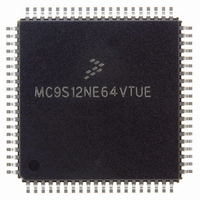MC9S12NE64VTUE Freescale Semiconductor, MC9S12NE64VTUE Datasheet - Page 339

MC9S12NE64VTUE
Manufacturer Part Number
MC9S12NE64VTUE
Description
IC MCU 64K FLASH EEPROM 80-TQFP
Manufacturer
Freescale Semiconductor
Series
HCS12r
Datasheet
1.MC9S12NE64VTU.pdf
(554 pages)
Specifications of MC9S12NE64VTUE
Core Processor
HCS12
Core Size
16-Bit
Speed
25MHz
Connectivity
EBI/EMI, Ethernet, I²C, SCI, SPI
Peripherals
POR, PWM, WDT
Number Of I /o
38
Program Memory Size
64KB (64K x 8)
Program Memory Type
FLASH
Ram Size
8K x 8
Voltage - Supply (vcc/vdd)
2.375 V ~ 3.465 V
Data Converters
A/D 8x10b
Oscillator Type
Internal
Operating Temperature
-40°C ~ 105°C
Package / Case
80-TQFP Exposed Pad, 80-eTQFP, 80-HTQFP, 80-VQFP
Processor Series
S12N
Core
HCS12
Data Bus Width
16 bit
Data Ram Size
8 KB
Interface Type
I2C, SCI, SPI
Maximum Clock Frequency
125 MHz
Number Of Programmable I/os
70
Number Of Timers
4
Operating Supply Voltage
- 0.3 V to + 3 V
Maximum Operating Temperature
+ 105 C
Mounting Style
SMD/SMT
3rd Party Development Tools
EWHCS12
Development Tools By Supplier
EVB9S12NE64E, DEMO9S12NE64E
Minimum Operating Temperature
- 65 C
On-chip Adc
10 bit, 8 Channel
Cpu Family
HCS12
Device Core Size
16b
Frequency (max)
25MHz
Total Internal Ram Size
8KB
# I/os (max)
70
Number Of Timers - General Purpose
4
Operating Supply Voltage (typ)
2.5/3.3V
Operating Supply Voltage (max)
2.625/3.465V
Operating Supply Voltage (min)
2.357/2.375/3.135V
Instruction Set Architecture
CISC
Operating Temp Range
-40C to 105C
Operating Temperature Classification
Industrial
Mounting
Surface Mount
Pin Count
80
Package Type
TQFP
For Use With
EVB9S12NE64E - BOARD EVAL FOR 9S12NE64DEMO9S12NE64E - DEMO BOARD FOR 9S12NE64
Lead Free Status / RoHS Status
Lead free / RoHS Compliant
Eeprom Size
-
Lead Free Status / Rohs Status
Lead free / RoHS Compliant
Available stocks
Company
Part Number
Manufacturer
Quantity
Price
Company:
Part Number:
MC9S12NE64VTUE
Manufacturer:
Freescale Semiconductor
Quantity:
10 000
Part Number:
MC9S12NE64VTUE
Manufacturer:
FREESCALE
Quantity:
20 000
- Current page: 339 of 554
- Download datasheet (4Mb)
11.4.3.2 Deferring
In half-duplex mode, if there is a carrier (the network is busy), the network node continues to listen until
the carrier ceases (network is idle). This is known as deferring to the passing traffic. As soon as the network
becomes idle (which includes waiting for the interframe gap interval), the network node may begin
transmitting a frame. The transmitter waits for the carrier sense to be negated for 60 bit times and then
begins transmit after another 36 bit times.
11.4.3.3 Collision Detection and Backoff
The collision detection and backoff feature is a normal part of the operation of Ethernet 802.3 MAC
protocol, and results in fast and automatic rescheduling of transmissions. This feature enables independent
network nodes to compete for network access in a fair manner. It provides a way for network nodes to
automatically adjust their behavior in response to the load of the network.
11.4.3.3.1
The collision window period is set to 64 byte times (512 bit times) starting after the SFD. If a collision
occurs within the collision window period, the retry process is initiated. If a late collision occurs (that is,
a collision after the collision window period), no retransmission is performed, the LCIF bit sets to 1, the
transmit retry counter is cleared, and transmission is aborted. If not masked (LCIE is set), the EMAC
generates a late collision interrupt. Due to latency associated with synchronizing the MII_COL signal,
assertions in the last three MII_TXCLK cycles of a normally completed transmission (during the FCS) are
ignored and a collision event is not recognized.
11.4.3.3.2
If a collision is detected anytime during transmission, the EMAC transmitter continues to transmit 32 bits
of data (called the collision enforcement jam signal) so that other devices on the Ethernet network,
including the offending transmitter, can detect the collision. If the collision is detected very early in the
frame transmission, the EMAC transmitter continues sending until it has completed the preamble of the
frame, after which it sends the 32 bits of jam data. If the collision is detected during the FCS, up to and
including the transfer of the last nibble of FCS data, the 32 bit jam is still sent.
11.4.3.3.3
After a collision occurs within the collision window period, the delay time that the EMAC transmitter
waits before attempting to retransmit the frame data is set at a multiple of the 512-bit Ethernet slot time.
The amount of total backoff delay is calculated by multiplying the slot time by a pseudo-randomly chosen
integer.
The backoff algorithm uses the following formula to determine the integer r, which is used to multiply the
slot time and generate a backoff delay.
Freescale Semiconductor
Collision Window
Jam Period
Backoff Generator
MC9S12NE64 Data Sheet, Rev. 1.1
0 r
≤
<
2
k
Functional Description
339
Related parts for MC9S12NE64VTUE
Image
Part Number
Description
Manufacturer
Datasheet
Request
R
Part Number:
Description:
Manufacturer:
Freescale Semiconductor, Inc
Datasheet:
Part Number:
Description:
Manufacturer:
Freescale Semiconductor, Inc
Datasheet:
Part Number:
Description:
Manufacturer:
Freescale Semiconductor, Inc
Datasheet:
Part Number:
Description:
Manufacturer:
Freescale Semiconductor, Inc
Datasheet:
Part Number:
Description:
Manufacturer:
Freescale Semiconductor, Inc
Datasheet:
Part Number:
Description:
Manufacturer:
Freescale Semiconductor, Inc
Datasheet:
Part Number:
Description:
Manufacturer:
Freescale Semiconductor, Inc
Datasheet:
Part Number:
Description:
Manufacturer:
Freescale Semiconductor, Inc
Datasheet:
Part Number:
Description:
Manufacturer:
Freescale Semiconductor, Inc
Datasheet:
Part Number:
Description:
Manufacturer:
Freescale Semiconductor, Inc
Datasheet:
Part Number:
Description:
Manufacturer:
Freescale Semiconductor, Inc
Datasheet:
Part Number:
Description:
Manufacturer:
Freescale Semiconductor, Inc
Datasheet:
Part Number:
Description:
Manufacturer:
Freescale Semiconductor, Inc
Datasheet:
Part Number:
Description:
Manufacturer:
Freescale Semiconductor, Inc
Datasheet:
Part Number:
Description:
Manufacturer:
Freescale Semiconductor, Inc
Datasheet:











